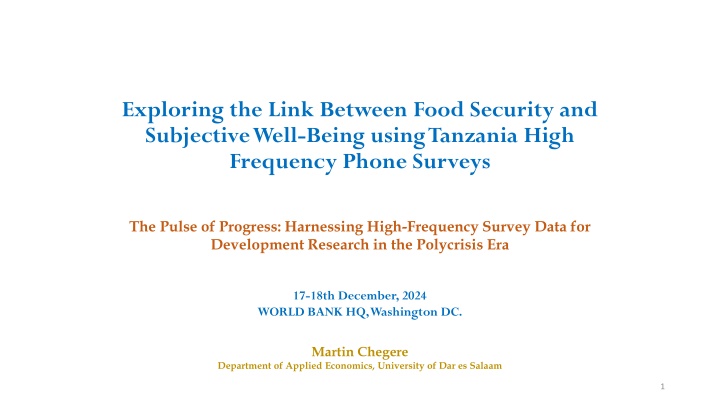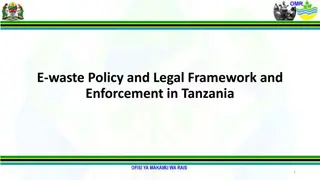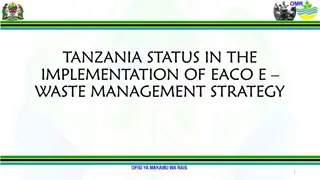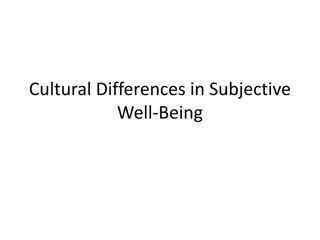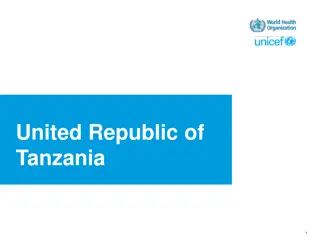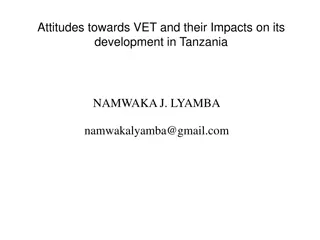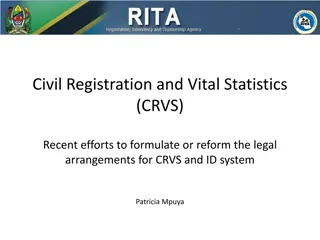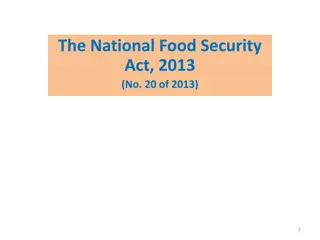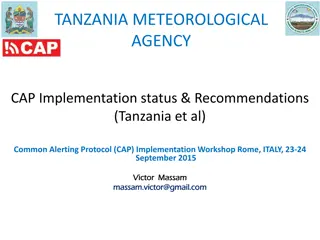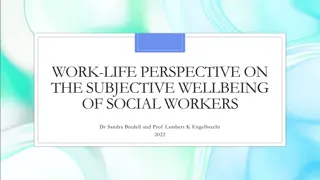Link Between Food Security and Subjective Well-Being in Tanzania
This study delves into the association between food security and subjective well-being, emphasizing how economic factors impact individuals' experiences towards well-being in developing countries like Tanzania. It explores the psychological and health consequences of food insecurity, wealth inequalities, and broader economic and social implications, shedding light on the interconnectedness of sustainable development goals.
Download Presentation

Please find below an Image/Link to download the presentation.
The content on the website is provided AS IS for your information and personal use only. It may not be sold, licensed, or shared on other websites without obtaining consent from the author.If you encounter any issues during the download, it is possible that the publisher has removed the file from their server.
You are allowed to download the files provided on this website for personal or commercial use, subject to the condition that they are used lawfully. All files are the property of their respective owners.
The content on the website is provided AS IS for your information and personal use only. It may not be sold, licensed, or shared on other websites without obtaining consent from the author.
E N D
Presentation Transcript
Exploring the Link Between Food Security and Subjective Well-Being using Tanzania High Frequency Phone Surveys The Pulse of Progress: Harnessing High-Frequency Survey Data for Development Research in the Polycrisis Era 17-18th December, 2024 WORLD BANK HQ, Washington DC. Martin Chegere Department of Applied Economics, University of Dar es Salaam 1
Introduction Global Well-Being Agenda: Improving well-being is a key goal for nations globally and locally, promoting sustainable development and enhanced quality of life. SDG 3 Good Health & Well-Being: Ensures healthy lives and promotes well-being at all ages, emphasizing quality healthcare, healthy lifestyles, and risk prevention. Interconnected SDGs: SDG 1 (No Poverty), SDG 2 (Zero Hunger), and SDG 8 (Decent Work and Economic Growth) are vital for economic empowerment, basic needs, and reducing disparities. Link between SDG 2 & SDG 3: In developing countries, food insecurity and poor health outcomes are tightly connected, making food security a critical part of enhancing well-being. 2
Food Security and Subjective Well-being (SWB) Food Security: Consistent access to sufficient, safe, and nutritious food for an active and healthy life (FAO, 1996). Subjective Well-Being (SWB): Measures life satisfaction, happiness, and emotional balance (Diener et al., 1999). Impact of Food Insecurity: Food insecurity correlates with lower SWB, leading to stress, anxiety, and diminished life satisfaction, especially in low- and middle-income countries. Economic Factors Affecting Well-Being: Food price inflation and income stability shape food security and SWB; unmet aspirations, especially regarding income and food security, can reduce life satisfaction (Mekonnen and Gerber, 2016). Aim: To examine the interplay between food security, income, and aspirations, and how these factors collectively shape individuals experiences of well-being 3
Literature Review: Role of Food Security on SWB Traditional Economic Models: Often equate welfare with utility derived solely from consumption. Psychological Consequences of Food Insecurity: Stress, anxiety, and fear about the future are overlooked by traditional models. (Stutzer, 2010). Empirical Findings: Studies consistently show a negative correlation between food insecurity and SWB, particularly in regions like Sub-Saharan Africa (Kornher & Sakketa, 2021; Sulemana & James, 2019). Physical Health and Emotional Burdens: Lack of nutritious food leads to illness and malnutrition, exacerbating psychological distress and creating a vicious cycle (Kornher & Sakketa, 2021). Wealth Discrepancies: The impact of food insecurity on SWB may be more severe in developed countries due to higher expectations of food security (Frongillo et al., 2018). 4
Broader Economic and Social Implications Food Distribution and Inequality: Perceptions of unfair food distribution can lower SWB even among those not directly affected by food insecurity (Kornher & Sakketa, 2021). Economic Factors Food Price Inflation: Rising food prices exacerbate food insecurity, particularly for low-income groups, leading to a direct decline in SWB (Alem & K hlin, 2014). Aspiration Failure Framework: Unmet aspirations related to food security and income can contribute to frustration and lower SWB (Mekonnen & Gerber, 2016). Impact on Physical Health: Lack of nutritious food increases vulnerability to illness and malnutrition. Hedonic Adaptation: Individuals in low-income countries may have adjusted their expectations and life satisfaction benchmarks due to persistent food insecurity. Study Contribution: This research explores the complex pathways between food security, aspirations, and SWB, focusing on developing countries. 5
Data Data Source: The study uses data from the 7th to 10th waves of the Tanzania High Frequency Welfare Monitoring Phone Survey (HFWMPS), conducted by the National Bureau of Statistics (NBS) of Tanzania with World Bank support. Survey Design: The HFWMPS is bi-monthly, with surveys lasting 20 minutes. It is based on households from the National Panel Survey (NPS) 2014/15, Mainland Household Budget Survey (HBS) 2018, and Zanzibar HBS 2019/20. Sample Size: Target of ~3,000 households per wave. Actual responses: Wave 7 (2,160), Wave 8 (2,093), Wave 9 (2,033), Wave 10 (1,981). A balanced panel of 1,721 households was consistently contacted across all waves. Survey Structure: Two subsamples were used, with alternating questions on Subjective Well-Being (SWB) and food security to reduce respondent fatigue and ensure robust data collection over time. 6
Descriptive Statistics N Mean SD 0.49 0.45 0.27 0.37 0.50 0.50 0.50 0.49 0.49 0.41 0.43 0.35 2.25 12.91 3.09 0.43 0.48 468.88 717.23 795.71 1381.72 0.32 0.10 0.14 0.31 Min Max SWB on food (Inadequate=1) SWB on health (Inadequate=1) SWB on income (Fair=1) SWB general (Happy=1) Worried about food (Yes=1) Unable to eat healthy (Yes=1) Ate few kinds of food (Yes=1) Skipped meal (Yes=1) Ate less food (Yes=1) Ran out of food (Yes=1) Hungry but didn t eat (Yes=1) Didn t eat whole-day (Yes=1) Food insecurity index Age of respondent (years) Household size Sex of respondent (Male=1) Location (Rural=1) Price maize flour Price rice Price beans Price beef Maize flour available (Yes=1) Rice available (Yes=1) Beans available (Yes=1) Beef available (Yes=1) 3440 3440 3440 3440 3440 3440 3440 3440 3440 3440 3440 3440 3440 3440 3440 3440 3440 2383 3236 2943 2771 3440 3440 3440 3440 .42 .28 .08 .83 .5 .55 .5 .43 .39 .21 .25 .14 -.01 51.05 6.08 .76 .63 1758.04 2567.26 2999.41 8399.03 0.88 0.99 0.98 0.90 0 0 0 0 0 0 0 0 0 0 0 0 1 1 1 1 1 1 1 1 1 1 1 1 -2.78 4.74 100 24 22 1 0 0 1 1 500 1200 800 1000 15000 28000 30000 14000 0 0 0 0 1 1 1 1 7
Estimation Strategy Quantitative Approach: Econometric analysis is used to examine how food security (FS) affects subjective well-being (SWB) across different dimensions (food, health, income, life satisfaction). Key Models: SWB Model: ?????= ? + ?????+ ???? + ??+ ??+ ??? SWB indicators: food, health, income, and life satisfaction; FS indicators: food worry, access, variety, meals skipped. Food Insecurity Model: ?????= ? + ?????+ ???? + ??+ ??+ ??? SA: societal factors like food availability and prices. Direct Societal Impact on SWB: ?????= ? + ?????+ ???? + ??+ ??+ ??? Panel Data Models: Fixed Effects (FE): Controls for individual-specific time-invariant characteristics. Random Effects (RE): Assumes unobserved heterogeneity is uncorrelated with covariates Correlated Random Effects (CRE): Combines time averages of covariates to handle correlation between heterogeneity and covariates. Endogeneity Considerations: Due to time-varying omitted variables (e.g., nutritional knowledge, health), the analysis identifies correlations, not causal relationships. (1) (2) (3) 8
Key Findings Food Insecurity on SWB Table 1: The marginal effect of food security aspects on SWB using CRE probit model (1) (2) (3) (4) (5) (6) (7) (8) (9) Food insecurity index VARIABLES Ate few kinds of food Hungry but didn t eat Worried about food Unable to eat healthy Skipped meal Ate less food Ran out of food Didn t eat whole-day SWB general (Happy=1) SWB on food (Inadequate=1) SWB on health (Inadequate=1) SWB on income (Fair=1) -0.210*** -0.194*** -0.196*** -0.202*** -0.203*** -0.199*** -0.205*** -0.143*** -0.0512*** (0.0130) (0.0137) (0.0129) (0.0121) (0.0118) 0.436*** 0.439*** 0.441*** 0.443*** 0.445*** (0.00776) (0.00885) (0.00705) (0.00643) (0.00694) 0.254*** 0.275*** 0.280*** 0.270*** 0.275*** (0.0139) (0.0142) (0.0132) (0.0129) (0.0128) -0.150*** -0.127*** -0.146*** -0.143*** -0.138*** -0.130*** -0.172*** -0.127*** -0.0405*** (0.0131) (0.0110) (0.0129) (0.0141) (0.0146) (0.0128) 0.404*** (0.0170) 0.214*** (0.0165) (0.0120) 0.443*** (0.0133) 0.259*** (0.0146) (0.0160) 0.395*** (0.0226) 0.273*** (0.0189) (0.00249) 0.107*** (0.00131) 0.0649*** (0.00274) (0.0202) (0.0244) (0.0238) (0.00362) Controls Observations YES 3,440 YES 3,440 YES 3,440 Standard errors in parentheses *** p<0.01, ** p<0.05, * p<0.1 YES 3,440 YES 3,440 YES 3,440 YES 3,440 YES 3,440 YES 3,440 9
Societal factors influencing food insecurity Table 2: The marginal effect of availability of main foods on food insecurity using CRE model (1) VARIABLES Maize flour available Availability of main foods -0.546*** (0.113) (2) (3) (4) Rice available -0.707** (0.336) Beans available -0.550** (0.255) Beef available 0.772*** (0.128) Controls Observations YES 3,440 YES 3,440 YES 3,440 YES 3,440 Table 3: The marginal effect of price of main foods on food insecurity using CRE model (1) VARIABLES Price maize flour Price of main foods 0.517*** (0.186) (2) (3) (4) Price rice 0.755*** (0.206) Price beans 0.848*** (0.172) Price beef -0.0506 (0.220) Controls Observations YES 2,383 YES 3,236 YES 2,943 YES 2,771 Standard errors in parentheses *** p<0.01, ** p<0.05, * p<0.1 10
Impact of food availability and prices on SWB Table 4: The marginal effect of availability of main foods on general SWB using CRE probit model (1) VARIABLES Maize flour available Availability of main foods 0.0436** (0.0185) (2) (3) (4) Rice available 0.0778 (0.0479) Beans available 0.0704* (0.0371) Beef available 0.0630*** (0.0186) Controls Observations YES 3,440 YES 3,440 YES 3,440 YES 3,440 Table 5: The marginal effect of price of main foods on general SWB using CRE probit model (1) VARIABLES Price maize flour Price of main foods 0.0448 (0.0317) (2) (3) (4) Price rice -0.131*** (0.0346) Price beans 0.00191 (0.0298) Price beef 0.0601 (0.0386) Controls Observations YES 2,383 YES 3,236 YES 2,943 YES 2,771 Standard errors in parentheses *** p<0.01, ** p<0.05, * p<0.1 11
Conclusions This study explores the relationship between food security and subjective well-being (SWB) in Tanzania, utilizing data from the Tanzania High Frequency Welfare Monitoring Phone Survey (HFWMPS). Food insecurity negatively impacts SWB: concerns about food scarcity, inability to eat healthily, and limited food variety reduce life satisfaction. Positive link between food security and SWB: better food access enhances happiness related to food, health, and income. Key societal factors: Food availability (e.g., maize flour, rice, beans) reduces food insecurity, while rising food prices increase food insecurity and lower SWB. 12
Policy Implications & Recommendations Increase food availability: Improve local access to essential foods (e.g., maize flour, rice, beans) to reduce food insecurity. Control food prices: Implement price regulation and subsidies for key staples to improve affordability. Strengthen social safety nets: Expand programs that provide financial or food assistance to vulnerable groups. Promote nutritional education: Improve knowledge about healthy eating to mitigate the impacts of food insecurity on health. Invest in agricultural development: Support smallholder farmers to increase local food production and availability. Address socio-economic disparities: Reduce income inequality and support marginalized communities to improve overall well-being. 13
